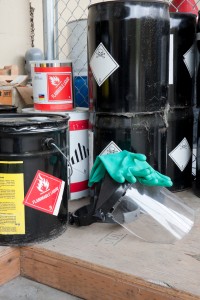Sludge Waste in Ohio Case Study
This article covers a case study in Southwest Ohio regarding sludge waste and how it is handled by RCRA.
What is sludge waste?
 Sludge waste is a mixture of liquid and solid components and is usually the product of an industrial or refining process. This semi-solid slurry could be hazardous and if it were, it would require a specific, safe, disposal protocol. A local industrial client contracted with TKEC to sample two (2) 55-gallon drums of sludge waste they had identified and were unsure if posed a potential hazard.
Sludge waste is a mixture of liquid and solid components and is usually the product of an industrial or refining process. This semi-solid slurry could be hazardous and if it were, it would require a specific, safe, disposal protocol. A local industrial client contracted with TKEC to sample two (2) 55-gallon drums of sludge waste they had identified and were unsure if posed a potential hazard.
Background
Hazardous waste has been regulated in the US since 1976 with the Resource Conservation and Recovery Act, commonly referred to as RCRA. RCRA is our nation’s primary law governing the disposal of solid and hazardous waste. Congress passed RCRA on October 21, 1976 to address the increasing problems the nation faced from our growing volume of municipal and industrial waste. RCRA, which amended the Solid Waste Disposal Act of 1965, set national goals for:
- Protecting human health and the environment from the potential hazards of waste disposal.
- Conserving energy and natural resources.
- Reducing the amount of waste generated.
- Ensuring that wastes are managed in an environmentally-sound manner.
To achieve these goals, RCRA established three distinct, yet interrelated, programs:
- The solid waste program, under RCRA Subtitle D, encourages states to develop comprehensive plans to manage nonhazardous industrial solid waste and municipal solid waste, sets criteria for municipal solid waste landfills and other solid waste disposal facilities, and prohibits the open dumping of solid waste.
- The hazardous waste program, under RCRA Subtitle C, establishes a system for controlling hazardous waste from the time it is generated until its ultimate disposal — in effect, from “cradle to grave.”
- The underground storage tank (UST) program, under RCRA Subtitle I, regulates underground storage tanks containing hazardous substances and petroleum products.
Case Study in Determining Hazardous Waste
Likewise, in this case, the purpose of the sampling was to determine if the sludge waste had hazardous characteristics for disposal purposes. A representative sample from each drum was collected and analyzed for:
- Eight (8) RCRA metals (arsenic, barium, cadmium, chromium, lead, mercury, selenium and silver) by the Toxicity Characteristic Leaching Procedure (TCLP)
- Volatile organic compounds
- Semi-volatile organic compounds
Steps for Sampling Procedures
- The drum lid was carefully removed to expose the surface of the sludge waste.
- Since some stratification of sludge may have occurred, a special sampling device was used to obtain a sample from the total depth of the sludge in each drum.
- The sample was placed into pre-cleaned 4-oz sample jars with Teflon-lined lids that were provided by the laboratory.
- Pertinent information including sample number, date and time was recorded on the sample label and affixed to the appropriate sample jar.
- The sample jars from each drum was placed in a re-sealable plastic bag and placed in an iced cooler for transport to the laboratory.
- Chain-of-Custody procedures were adhered to in the field and laboratory.
The analytical results indicated low levels of two (2) RCRA Metals in each drum. The levels detected were well below regulatory levels. Volatile Organic Compounds (VOCs) and Semi-Volatile Organic Compounds (SVOCs) were not detected in either drum.
What did this mean for the client? It meant a cost savings for disposal purposes. While the sludge still needed to be disposed of properly, it did not have hazardous waste characteristics, resulting in disposal cost savings. A certified waste disposal company was used to remove the drums from the premises.
TKEC can help your company comply with regulations covering sludge waste and hazardous materials.


